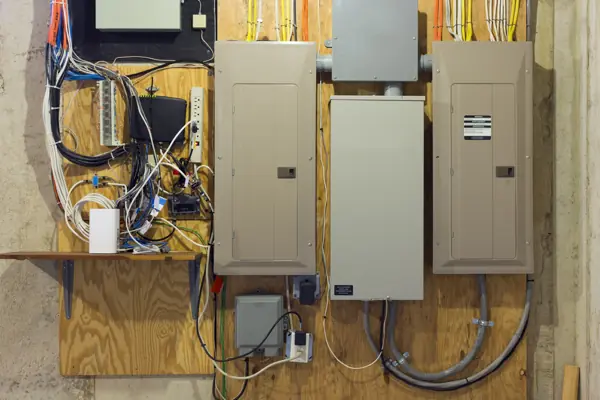
You’ve probably experienced a sudden power surge that fried your favorite appliances, leaving you frustrated and out of pocket. But have you ever considered that the root cause might be your breaker panel? This often-overlooked part of your home’s electrical system can be the reason behind those damaging surges.
While a well-functioning breaker panel protects your home from electrical overloads, when it fails, it can cause big problems. It’s something many homeowners forget to check, but understanding how a faulty panel affects your appliances could save you a lot of trouble in the long run.
How do breaker panel failures contribute to power surges?
Breaker panel failures contribute to power surges by allowing electrical current to flow unchecked, leading to sudden spikes in voltage that can damage appliances and electronics. Here’s how it happens:
- Inadequate Tripping Mechanism: The primary function of a breaker panel is to trip (shut off) the power when an overload or short circuit occurs. However, if the breaker panel is old, faulty, or improperly installed, the breakers may fail to trip during a surge, allowing excessive current to continue flowing through the circuits.
- Overloaded Circuit: The circuit may become overloaded when too many high-powered appliances run simultaneously. Without a functioning breaker, this overload can cause power surges by forcing more electricity through the system than it can handle.
- Worn-Out Components: As breaker panels age, the internal components, like circuit breakers and wiring, can wear out or degrade. A worn-out breaker may fail to respond to overloads, leaving the system vulnerable to sudden electrical spikes.
- Faulty Wiring: Improperly installed or damaged wiring can also lead to power surges. If the breaker fails to detect these issues, the current can spike, causing voltage irregularities that affect appliances.
When a breaker panel fails to function properly, it can’t prevent electrical surges, putting your home’s electronics and appliances at risk.
What are the signs of a failing breaker panel that can lead to appliance damage?
A failing breaker panel can cause serious issues, including power surges that lead to appliance damage. Here are some signs that your breaker panel may be failing:
- Frequent Tripped Breakers: If the breakers in your panel trip regularly, it could indicate an underlying issue with the panel or an overload in the system. While occasional tripping is normal, frequent occurrences may suggest that the breakers are worn out and unable to handle the load properly.
- Flickering or Dimming Lights: If your lights flicker or dim intermittently, it could be a sign of a faulty breaker or circuit not providing stable electricity. This can lead to power surges, damaging sensitive appliances and electronics over time.
- Unusual Sounds or Smells: If you hear buzzing, humming, or popping sounds coming from the breaker panel or notice burning smells, it’s a clear indication of electrical problems. These could be caused by overheating, short circuits, or loose connections, which increase the risk of power surges.
- Warm or Hot Breaker Panel: A breaker panel that feels warm or hot to the touch is a serious sign of a problem. It could indicate overloaded circuits, poor connections, or internal faults, which may lead to power surges.
- Discolored or Burnt Marks: Check for visible signs of burning, discoloration, or melted areas on the breaker panel. This can happen due to overheating, electrical surges, or faulty wiring, increasing the risk of damaging your appliances.
- Aging Panel: If your breaker panel is over 20-30 years old and hasn’t been upgraded, it may no longer meet the demands of modern electrical systems, leaving it vulnerable to failure and power surges.
If you notice any of these signs, it’s important to have your breaker panel inspected and repaired by a licensed electrician to prevent appliance damage and ensure your electrical system is safe.
Why is an outdated breaker panel a risk for electrical safety?
An outdated breaker panel poses several risks to electrical safety due to its inability to handle the demands of modern electrical systems. Here’s why it’s a safety hazard:
- Inability to Handle Modern Loads: Older breaker panels support fewer weaker appliances. As homes employ increasingly high-powered devices, an antiquated panel may not be able to handle the load, causing overloads and electrical fires.
- Faulty Circuit Breakers: Breakers might fail to trigger during overloads or short circuits due to internal component degradation. This failure prevents electrical current from being switched off, causing power surges, sparks, or overheating, increasing appliance damage and fire risk.
- Lack of Grounding and Surge Protection: Many older breaker panels lack grounding and surge protection, which are necessary for electrical surge safety and electronics protection. Without these precautions, an obsolete panel risks deadly voltage spikes.
- Deterioration of Wiring: Aging wiring connected to old breaker panels can wear out, exposing wires or causing loose connections. This deterioration heightens the risk of electrical shorts, shocks, and fires.
- Code Violations: Outdated panels may not comply with modern electrical codes, potentially violating safety standards and increasing the risk of accidents, electrical malfunctions, and costly repairs.
Replacing an outdated breaker panel ensures your electrical system meets current safety standards, preventing hazards like overloads, electrical fires, and equipment damage.
How can a faulty breaker panel impact home energy efficiency?
A faulty breaker panel can significantly negatively impact your home’s energy efficiency. Here’s how:
- Inconsistent Power Distribution: A faulty breaker panel can cause inefficient power distribution across circuits, giving some parts of your home too much power. Inefficient energy consumption can increase expenditures because some appliances use more electricity than needed.
- Frequent Power Surges: A malfunctioning breaker panel may not trip during overloads, causing power surges. Surges damage appliances and waste energy by making them inefficient or unpredictable. Surges may increase power consumption for appliances and devices, diminishing efficiency.
- Overloaded Circuits: Your obsolete or malfunctioning breaker panel may not be able to handle modern electrical loads. Because appliances and devices struggle to work under load, overloaded circuits can waste electricity and cause equipment failure.
- Inability to Use Energy-Saving Features: Smart power management and load distribution save energy in many modern appliances. Due to flaws or aged components, the breaker panel may not manage these characteristics well, reducing appliance efficiency.
- Increased Heat Generation: Faulty wiring or breakers can cause excessive heat in the panel, which wastes energy and can increase cooling needs in your home, further driving up energy costs.
Ensuring your breaker panel is functioning properly, you can maintain better energy efficiency, reduce waste, and lower electricity bills.
Protect Your Home from Breaker Panel Failures Today
At The Go-To Crew Electric, we understand that breaker panel failures are a common yet often overlooked cause of power surges and appliance damage. A faulty or outdated breaker panel can lead to electrical issues, damaging your appliances and increasing energy costs.
Our team of experts specializes in inspecting, repairing, and upgrading breaker panels to ensure your home’s electrical system is safe and efficient. Don’t wait for a power surge to damage your valuable appliances. Let us help you protect your home from electrical hazards!
